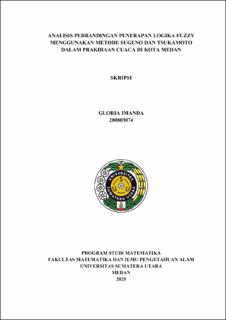Analisis Perbandingan Penerapan Logika Fuzzy Menggunakan Metode Sugeno dan Tsukamoto dalam Prakiraan Cuaca di Kota Medan
Comparative Analysis of The Application of Fuzzy Logic Using The Sugeno and Tsukamoto Method in Weather Forecasting in Medan City

Date
2025Author
Imanda, Gloria
Advisor(s)
Nasution, Putri Khairiah
Putri, Mimmy Sari Syah
Metadata
Show full item recordAbstract
This study aims to compare the Sugeno and Tsukamoto methods applied in weather forecasting using Fuzzy Logic. The input variables include air temperature, humidity, sunlight duration, and wind speed, while the output variable comprises weather categories: no rain, light rain, moderate rain, and heavy rain. The data used are secondary data obtained from the Meteorology, Climatology, and Geophysics Agency (BMKG) Region I Medan for October 2024. The Sugeno and Tsukamoto methods were implemented to forecast the weather in Medan City. The performance of both methods was evaluated using the sign test with a binomial distribution against actual weather data. The results showed that the Sugeno method produced 7 positive signs and 2 negative signs (p-value = 0.0898), while the Tsukamoto method produced 5 positive signs and 2 negative signs (p-value = 0.2264). Since both p-values are greater than the significance level of 0.05, it can be concluded that there is no statistically significant difference between the forecast results of the two methods and the actual data. However, the smaller p-value of the Sugeno method indicates a closer alignment with the actual data, suggesting that this method has better accuracy than the Tsukamoto method. A linear regression model was used to predict the input variable values for the 32nd and 33rd data entries. Both methods forecasted moderate rain for these entries, while the actual data showed moderate rain and heavy rain. This indicates that both methods were able to provide forecasts that closely matched actual weather conditions.
Collections
- Undergraduate Theses [1486]
